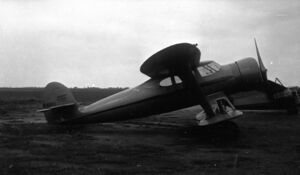Brown-Young BY-1
Topic: Engineering
 From HandWiki - Reading time: 2 min
From HandWiki - Reading time: 2 min
| BY-1 | |
|---|---|

| |
| Role | Cabin biplane |
| National origin | United States |
| Manufacturer | Columbia Aircraft Co., Tulsa OK |
| Designer | Richard E. Young, Willis Brown |
| Introduction | 1936 |
| Number built | 1 |
The Brown-Young BY-1, also called the Columbia Sesquiplane and the Model 2, was a prototype sesquiplane from Columbia Aircraft Co.
Design and development
Richard E. Young was the inventor of Spiralloy, a directional glass fibre composite material used in high-strength applications. Together with Willis C. Brown he designed and built the BY-1, a four-seat equivalent to the two-seat Luscombe Phantom parasol monoplane.[1][citation needed] After completion, a smaller lower wing was mounted below the fuselage, converting it to a sesquiplane with backward staggered wings. The lower wing also housed the retractable landing gear main wheels.[2]
The wings were fabric covered, while the fuselage was of all-metal construction and supported the non-retractable tailwheel.[3] A single Jacobs radial engine in the nose drove a two-bladed propeller.
Operational history
The engine from the BY-1 was later installed in the prototype MB-10 trainer. The BY-1 was scrapped at White Rock Airport in Dallas, Texas for materials during the Second World War.[2]
Specifications (Brown-Young BY-1)
Data from [1](aerofile.com)
General characteristics
- Crew: 1
- Capacity: 3
- Powerplant: 1 × Jacobs L-4 Radial, 225 hp (168 kW)
- Propellers: 2-bladed
See also
Aircraft of comparable role, configuration and era
- Beechcraft Staggerwing
- Luscombe Phantom
References
- ↑ 1.0 1.1 "Aerofiles = Bown-Young". aerofiles.com. 17 April 2009. http://www.aerofiles.com/_bo.html.
- ↑ 2.0 2.1 Skyways (55): 47. July 2000.
- ↑ Wood, Peter. "Rocket Science". Archived from the original on 6 July 2010. https://web.archive.org/web/20100706062705/http://www.nas.org/polArticles.cfm?doc_id=438. Retrieved 7 January 2012.
External links
 |
 KSF
KSF